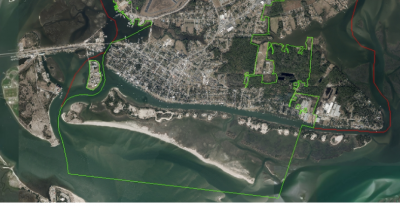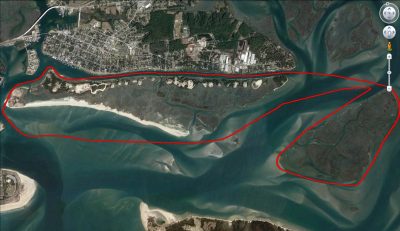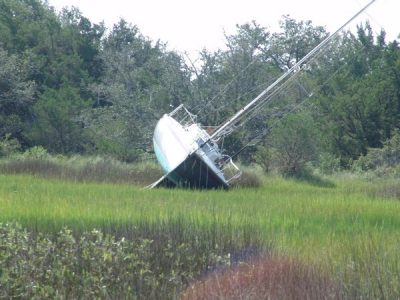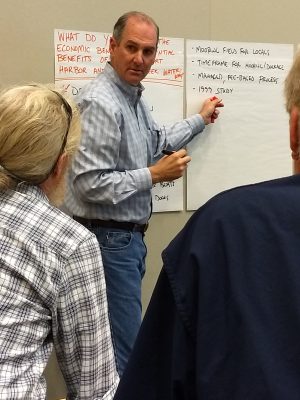
BEAUFORT – Concerns about marine debris, derelict and abandoned vessels in Taylor’s Creek and having the waterway remain an attraction for transient boaters were some of the key issues the more than 70 residents voiced last week during the Beaufort Harbor management public meeting.
Held at the National Oceanic and Atmospheric Administration Fisheries Beaufort Lab in partnership with the town and the North Carolina Coastal Reserve and National Estuarine Research Reserve, which manages the Rachel Carson Reserve, the meeting is part of an effort to clean up Taylor’s Creek, the body of water separating downtown Beaufort waterfront and the reserve.
Supporter Spotlight
Town Mayor Rett Newton explained that the harbor management piece is very complex and part of a bigger clean water coastal community initiative for Beaufort.
In the early 2010s, while volunteering at Rachel Carson Reserve, Newton said a sailboat caught fire and sank in the middle of Taylor’s Creek, becoming a hazard to navigation. Then in February 2016, he watched from the Duke Marine Lab dock as a waterspout came in, causing about a dozen vessels to drag anchor toward Beaufort docks.
“It was very fortunate that the boats stopped short of the docks,” he said. “Just imagine what would have happened if they had gotten hung up in the docks, if they had been hung up around some of the vessels that were there as well.”
In addition to the hazards derelict and abandoned boats present, there are concerns about water quality, such as gray water, which is household wastewater from washing clothes, bathing, showering and from the kitchen, and blackwater, which is wastewater from toilets, as well as Beaufort services being used by without paying for Beaufort services, he said.
Town Manager John Day explained to the residents gathered that Beaufort has the ability to deal with abandoned and derelict vessels in the waterway but he said the town feels that it’s important to hear what citizens are concerned about, what they see as safety issues, how they want Taylor’s Creek to look. “What’s important to you.”
Supporter Spotlight
Day added that as staff and officials receive feedback from residents, the town board of commissioners then will be able to decide the direction they want to move. If the board wishes to move forward, there will be drafts of possible ordinances and regulations and more public meetings for feedback.

The town has had authority since 1981 to make, adopt and enforce ordinances for navigable waters within the town limits, Day explained. That authority includes regulating the operation and anchoring of boats and vessels, speed zones, no-wake zones and other types of activities, the placement and maintenance of channel aids and markers and making general rules and regulations for the safe and proper use of waters for the occupants of boats and vessels, swimmers and fishermen.
“It’s fairly broad authority,” Day added.
Last fall, he said he had the moorings in Taylor’s Creek pinpointed. Though none of these moorings were permitted, they’ve been there a long time, he said.
To receive a permit, someone either has to have riparian rights or have been given the use of those rights by the property owner. The Coastal Resources Commission, or CRC, issues permits under the purview of Coastal Area Management Act, or CAMA. There are no records of any permits for moorings, which is an issue, he said.
Day continued that he found while reviewing the enabling legislation that the town has the authority to put moorings in and manage the mooring fields if it decides to do so but it also has the authority to regulate areas where anchorage is permitted, if it chooses, adding to why it is important to hear from town residents.
Paula Gillikin, who manages the Rachel Carson Reserve, explained to the crowd that the reserve partners with the town on various management issues, including waterway management issues.

The reserve performed some mapping in conjunction with the town’s effort to better understand what boats were inside the reserve boundary, they also recorded if the boats were anchored or moored, the types of vessels as well as documented registration numbers. Out of 40 moorings in the creek, 13 are within the boundaries of Rachel Carson Reserve.
She said while most of the time, boat owners will retrieve their vessels once it’s on the reserve, there are occasions that the boats are abandoned because the owners are no longer in the area or don’t have the financial resources.
“Some of the vessels become stranded on the reserve for months at a time, and then it takes us months to work through our legal layers to address those vessels,” she added that recently they’ve been able to work with the town, which has exercised its abandoned vessels ordinance, to help remove abandoned boats.
“In the past 10 years, we’ve had 15 boats that have landed on the reserve for what I’ll call a significant amount of time, and that’s more than a matter of days, it’s a matter of weeks or months,” she added.
The site is protected as a pristine coastal reserve, Gillikin explained, but it is also maintained for education and research uses as well as for the public to visit. In addition, the reserve is also a good buffer for the town, reducing its vulnerability to storms.
When vessels wash up on the reserve, they must be pulled off, causing the reserve to lose chunks of shoreline.

“Naturally, when you pull a vessel off, it’s going to slough some of that sediment and marsh off,” she continued. “That’s definitely causing some habitat damage, in some cases more extensive than others.”
One vessel abandoned on the reserve had copious amounts of drug paraphernalia on board, she said. The boat was on the reserve for a while as officials were trying to figure out how to remove it.
Gillikin said to address the issue of derelict and abandoned boats, as well as some other issues in the waterway, the town and reserve applied to the NOAA marine debris program for a grant to remove medium and large objects, primarily submerged in the creek, to improve habitat conditions.
She said the need is for about $175,000 total. That number breaks down to a $4,000 cash match, about $103,000 will be an in-kind match and they’ve applied for about $67,000 in grant funds from NOAA.
Those funds can be used to remove some of the sunken vessels in the creek and address different areas of bottom debris if it’s not currently serving as habitat for fish or shellfish.
Gillikin said that as a pilot project, the reserve worked with Towboat US to map with sonar half of the creek and found at least three sunken sailboats, which could potentially be removed using funding from the NOAA grant.
After hearing the presentations to get a better idea of the hurdles town and the reserve face with Taylor’s Creek, attendees were split into five groups to participate in a roving flip chart exercise. They were asked to answer the following five questions:
- What do you see as the economic benefit or potential benefits of the Beaufort Harbor and Taylor’s Creek waterway?
- Do you have concerns about how the harbor looks?
- Do you have concerns about harbor safety?
- Do you have concerns about harbor function and accessibility for locals, visitors and transient boaters?
- Do you have concerns about the habitats and water quality in our harbor? Sailboats in the Harbor?

Regarding how the harbor looks, most everyone agreed that while the view is appreciated, boats that are derelict or in bad condition distract from the waterfront’s charm. Other concerns related to litter in the marsh and the remains of sunken boats.
As for harbor function, largely there was worry about the lack of organization for boaters, assistance for transient boaters and no enforcement of the no-wake zone. Additionally, there was a consensus about the need for a registration system for all boats, a harbor master, a fee and liability insurance.
With habitat and water quality concerns in the harbor, residents felt it would be important to have a baseline of what is happening now in the waterway. The primary concerns, however, focused on stormwater runoff, marine debris and sewage outflow, plus there was a mixed consensus on the effect of boat traffic on the habitat.
Safety concerns in the harbor included submerged and non-submerged hazards, the need for more signage and enforcement of the no-wake zone, vessels breaking loose or dragging from its mooring or anchor, better management of transient boaters and issues with anchoring within the federal channel.
It was agreed that the harbor is an economic benefit because it is an attraction to the area. However, some residents felt that there was lost opportunity because boaters avoid Beaufort due to lacking structure in the waterway. Suggestions were made for affordable mooring and accessible pump out stations, as well as communicating with the cruising communities because transient boaters are vital to the businesses.
“We were really very pleased at the level of response that we had and the willingness toward a better harbor management plan,” Newton said after the meeting. “The community engagement was excellent.”
He added that the town appreciated the help of Gillikin and Whitney Jenkins, training coordinator for the coastal reserve, for putting it all together.
Newton explained that he and Day have been talking about a harbor management plan for quite some time, and now it’s building some momentum. The next step is to synthesize the information, see what the data says and take it to the board of commissioners. As the plan develops, there will be more public sessions.
“This is all part of a clean water community as well, it has components of that clean water community,” he said.
Gillikin echoed Newton.
“The meeting was well attended, with 72 members of the public enthusiastically participating in the facilitated input session,” she told Coastal Review Online after the meeting. “It’s important to make sure that the public can make meaningful contributions to launching a process that will ultimately enhance Beaufort’s harbor and waterway for visitors and locals alike. I think the meeting accomplished this well. We are receiving positive feedback from many participants who felt that their opinions were efficiently and effectively captured during the meeting.”







